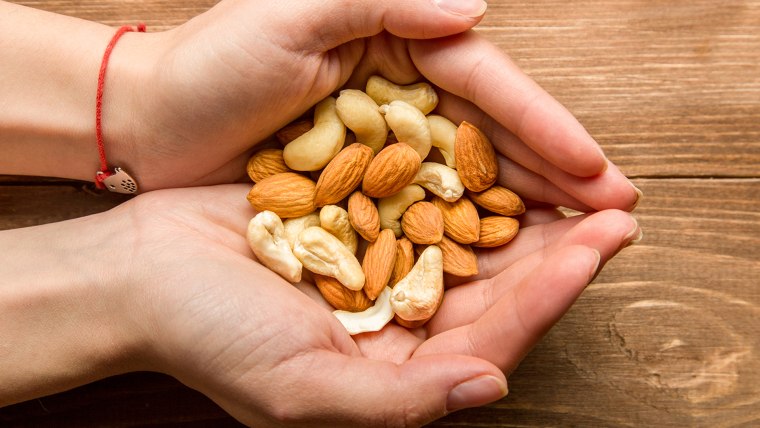Healthy weight loss comes with its own checklist.
Dr. Michael Greger, a physician who specializes in clinical nutrition, calls it his Daily Dozen — a summary of all the “healthiest of healthy foods” and habits he tries to fit into his daily routine to stay slim and prevent disease.
Eating all of the items on the list is filling, but adds up to 1,250-1,500 calories — or about 500 calories less than people normally eat, leading to weight loss, Greger said.
The list also nudges people towards a whole-food, plant-based diet, which he recommends in his book, “How Not to Diet: The Groundbreaking Science of Healthy, Permanent Weight Loss.”
Greger created the checklist to offer a basic guide to the eating plan, which minimizes the intake of meat, eggs, dairy and processed foods; and maximizes fruits, vegetables, whole grains, nuts and seeds.
“Just telling people to eat plants — people don’t know what that means,” Greger told TODAY. “I’m not talking about jelly beans, I’m talking about kidney beans… real food that grows out of the ground, from fields not factories. These are the healthiest choices.”
Some plants also have particular nutrients — including cancer-fighting compounds — that aren’t found anywhere else, so Greger’s checklist includes many of those super foods.
The list is the minimum people should eat, but it can easily become the limit, Greger said. “There’s just only so much room in your stomach and some of these foods are just so filling that the hope is if you really try to follow this, there’s just no room for junk,” he noted.
Here’s his Daily Dozen checklist:
1. Beans, 3 servings
That includes all sorts of beans like lentils, black-eyed peas, navy beans, chickpeas and so on. Beans are a powerhouse of good stuff — they contain fiber, protein and iron — and help you feel full.
Sample serving sizes:
- ¼ cup of hummus or bean dip
- ½ cup cooked beans, tofu or tempeh
- 1 cup of fresh peas
2. Berries, 1 serving
Go for strawberries, raspberries, blueberries, cherries and blackberries. Berries are high in antioxidants and fiber.
Sample serving sizes:
- ½ cup fresh or frozen berries
- ¼ cup dried berries
3. Other fruits, 3 servings
This delicious category includes apples, avocados, bananas, oranges, peaches, mangoes, pineapple, pears and many other favorite fruits. They’re high in vitamins and minerals.
Sample serving sizes:
- 1 medium-size fruit
- 1 cup cut-up fruit
- ¼ cup dried fruit
4. Cruciferous vegetables, 1 serving
Think broccoli, cauliflower, kale, collard greens, arugula, radishes and all types of cabbage. “They produce this stuff called sulforaphane, which has these remarkable benefits, but is found nowhere else,” Greger said.
Sample serving sizes:
- ½ cup chopped cruciferous vegetables
- ¼ cup brussels or broccoli sprouts
- 1 tablespoon horseradish
5. Greens, 2 servings
This group includes a mix of young salad greens, spinach, beet greens and kale.
Sample serving sizes:
- 1 cup of raw greens
- ½ cup cooked
6. Other vegetables, 2 servings
All the favorites are here, including carrots, corn, bell peppers, onions, tomatoes, sweet potatoes, mushrooms and many other veggies. Like fruits, they provide a variety of vitamins and minerals, and lots of fiber.
Sample serving sizes:
- ½ cup raw or cooked non-leafy vegetables
- ½ cup vegetable juice
7. Flaxseeds, 1 serving
Flaxseeds have cancer-fighting lignans, compounds that are essentially absent anywhere else, Greger said.
Sample serving size:
- 1 tablespoon of ground flaxseeds. Sprinkle it on your favorite foods.
8. Nuts and seeds, 1 serving
Go for almonds, cashews, pistachios, pumpkin seeds, sunflower seeds, walnuts and other favorites. Nuts are loaded with antioxidants and healthy fat, and help you feel satiated and full.
Sample serving sizes:
- ¼ cup nuts or seeds
- 2 tablespoons nut or seed butter
9. Herbs and spices
This category includes turmeric, cinnamon, chili powder, nutmeg, oregano and more. Turmeric is a powerful antioxidant and a way to fight inflammation in the body, some research shows.
Sample serving sizes:
- ¼ teaspoon of turmeric + any other salt-free herbs and spices you like
10. Whole grains, 3 servings
Think brown rice, oats, popcorn, quinoa, whole wheat pasta and barley. Whole grains help people absorb fewer calories, studies have found. Fiber, which is indigestible by the body, can trap sugars and block fat and starch as it moves through your system, Greger said.
Sample serving sizes:
- ½ cup hot cereal or cooked grains
- 1 slice of bread
- 3 cups popped popcorn
11. Beverages, 5 servings
Go for water, tea and coffee. Skip the cream and sugar.
Sample serving size:
- 1 12-ounce glass
12. Exercise, 1 serving
Every little bit of movement adds up and helps burn calories. You can get a good workout at home.
Sample serving sizes:
- 90 minutes of moderate-intensity activity like brisk walking, yoga or yard work.
- 40 minutes of vigorous activity, such as jogging, circuit weight training or swimming laps.
What to remember:
Greger knows the checklist will be more aspirational than realistic for many people, so he encourages small steps toward fulfilling his Daily Dozen. A good start might be sprinkling flaxseeds on any food you like or adding a banana to your oatmeal. His Daily Dozen app can help you keep track.
“The most important thing for people to realize is it doesn’t matter — unless you have some critical illness — what you eat today, or next week or next month. It’s what you eat for the rest of your life,” he said.
The goal is to find a healthy diet that’s sustainable, enjoyable and convenient.
“If it takes you two years to figure it out, then take two years. You’re going to benefit for the next 50 years. That’s how you have to think of it — really long-term,” Greger said.






